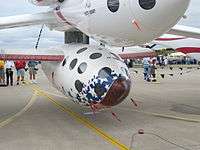Peter Siebold
| Peter Siebold | |
|---|---|
| Commercial Astronaut | |
| Nationality | American |
| Born | 1971 (age 44–45) |
Other occupation | Test Pilot |
| Selection | SpaceShipOne 2003 |
| Missions | None |
Peter Siebold (born 1971) is a member of the Scaled Composites astronaut team.[1] He is their Director of Flight Operations,[2] and was one of the test pilots for SpaceShipOne and SpaceShipTwo, the experimental spaceplanes developed by the company.[3] On April 8, 2004, Siebold piloted the second powered test flight of SpaceShipOne, flight 13P, which reached a top speed of Mach 1.6 and an altitude of 32.0 kilometers. On October 31, 2014, Siebold and Michael Alsbury were piloting the SpaceShipTwo VSS Enterprise on flight PF04, when the craft came apart in mid-air and then crashed, killing Alsbury and injuring Siebold.
Career
Peter Siebold, a 1990 graduate of Davis Senior High School in Davis, California,[4] obtained his pilot's license at age 16.[5] He has been a design engineer at Scaled Composites since 1996. Siebold holds a degree in aerospace engineering from California Polytechnic University at San Luis Obispo, from 2001.[5]
Siebold was responsible for the simulator, navigation system, and ground control system for the SpaceShipOne project at Scaled. Although he was one of four qualified pilots for SpaceShipOne, Siebold did not pilot the craft during the flights later in 2004 to meet the requirements of the Ansari X Prize.[6] Although Siebold flew SpaceShipOne to an altitude of 32 km (just under 20 miles), he did not cross the 100 km Kármán line—the international standard for reaching space.
For his contribution to the SpaceShipOne project, Siebold, along with Mike Melvill and Brian Binnie, received the 2004 Iven C. Kincheloe Award presented by the Society of Experimental Test Pilots.
Siebold became the Director of Flight Operations at Scaled.[2] He was the pilot who flew the White Knight Two on its maiden flight on December 21, 2008.[7] He won the Iven C. Kincheloe Award a second time in 2009, this time individually, for his work on the first WhiteKnightTwo, VMS Eve, as chief test pilot.[5]
SpaceShipTwo VSS Enterprise crash
On October 31, 2014, Siebold was one of the two pilots flying the Virgin Galactic SpaceShipTwo, VSS Enterprise, along with Michael Alsbury, on a test flight, which suffered an anomaly, resulting in the death of Michael Alsbury and loss of Enterprise. VSS Enterprise crashed in the California Mojave Desert. Siebold survived a descent from about 50,000 feet at Mach 1 speed with just a flightsuit.[8] The parachute deployed automatically at about 20,000 feet, and, after landing, he was taken to the hospital for treatment.[5]
References
- ↑ https://web.archive.org/web/20090524044812/http://www.space.com/php/multimedia/imagegallery/igviewer.php?imgid=1858&gid=154. Archived from the original on May 24, 2009. Retrieved March 6, 2007. Missing or empty
|title=(help) - 1 2 "Press Release – 3:00pm, November 1, 2014" (PDF). Scaled Composites. November 1, 2014. Retrieved November 5, 2014.
- ↑ https://web.archive.org/web/20061115195337/http://space.com/missionlaunches/spaceshipone__secretpilot_040618.html. Archived from the original on November 15, 2006. Retrieved March 6, 2007. Missing or empty
|title=(help) - ↑ "Surviving Pilot In SpaceShipTwo Crash Said To Be 'Alert And Talking'". Sacramento CBS local. November 1, 2014. Retrieved November 8, 2014.
- 1 2 3 4 Prigg, Mark; Spargo, Chris; Warren, Lydia; Corcoran, Kieran (October 31, 2014). "Moment Virgin Galactic spaceship exploded at 45,000ft". Daily Mail. Retrieved November 5, 2014.
- ↑
- ↑ "Scaled Composites: News – Mike Alsbury Memorial Fund" (PDF). Scaled Composites.
- ↑ Vartebedian, Ralph; Petersen, Melody (November 5, 2014). "Virgin Galactic pilot defied the odds to survive crash". Los Angeles Times. Retrieved November 8, 2014.
